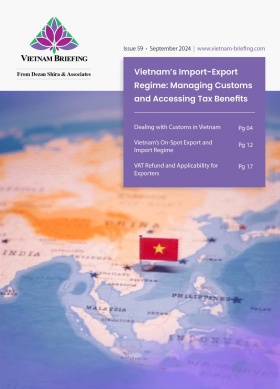Why Companies in Vietnam Choose to Restructure Their Businesses
As businesses face market shifts, economic pressures, and global competition, corporate restructuring in Vietnam has become a key strategy for sustaining and enhancing performance. This article explores Vietnam’s evolving business environment, common triggers for restructuring, and the available options for companies operating in the country.
Investment trends driving the need for restructuring
Vietnam’s business environment is influenced by both domestic and international factors. Global supply chain realignment, driven by geopolitical tensions and trade disputes, has prompted many multinationals to relocate operations to Vietnam.
The Vietnamese government’s efforts to create a favorable business climate through regulatory reforms, tax incentives, and streamlined bureaucracy have further attracted foreign investment. However, the influx of capital and new entrants has intensified competition, requiring companies to reconsider their structures to remain competitive and successful.
In 2024, Vietnam ranked among the world’s top 15 developing economies in foreign direct investment (FDI) attraction, with key sectors such as manufacturing, logistics, and technology driving growth. The Foreign Investment Agency (FIA) reported that Vietnam attracted over US$38.2 billion in FDI in 2024. The country’s FDI disbursement reached a record US$25.35 billion, a 9.4 percent increase from the previous year, reflecting strong business growth and confidence in Vietnam.
Key growth sectors in Vietnam
- Manufacturing: Vietnam’s manufacturing sector, particularly electronics, textiles, and machinery, drives economic growth. The country is a key player in global supply chains, benefiting from trade agreements such as CPTPP and EVFTA. As businesses expand, restructuring becomes essential to maintain efficiency and competitiveness.
- Technology and innovation: The rise of Industry 4.0 has fueled growth in sectors like fintech, e-commerce, and AI. As Vietnam advances its digital economy, businesses often restructure to consolidate resources, merge with startups, or adapt to market changes.
- Logistics and infrastructure: With major investments in road, rail, and port infrastructure, Vietnam’s logistics sector is critical to its manufacturing hub status. Companies are restructuring to optimize operations through joint ventures and mergers, responding to infrastructure upgrades and increased competition.
- Services: The services sector, including financial services, hospitality, and retail, is expanding with Vietnam’s growing middle class. In 2024, it became the primary driver of economic growth. Restructuring in this sector focuses on adapting to consumer preferences, consolidating operations, and seizing new market opportunities.
Common triggers for company restructuring in Vietnam
Businesses in Vietnam, both domestic and foreign-invested, pursue restructuring for various reasons. Common triggers include:
- Economic downturns: Despite its resilience, Vietnam’s economy is vulnerable to global economic fluctuations. Economic downturns, particularly in export-driven sectors, can force businesses to cut costs, improve efficiency, or refocus on more stable industries. The COVID-19 pandemic highlighted the vulnerability of sectors like tourism and hospitality, prompting downsizing or spin-offs as survival strategies.
- Market shifts: Rapid economic development and changing consumer behavior demand that businesses adapt to evolving preferences. With rising urbanization and disposable incomes, businesses that fail to meet these shifts may experience declining market shares. Retailers, for example, may restructure to emphasize e-commerce and digital marketing as consumer habits shift from traditional to online shopping.
- Operational inefficiencies: As companies expand, inefficiencies due to outdated systems or management structures often arise. Restructuring offers an opportunity to streamline operations, adopt new technologies, and optimize departments. In Vietnam’s competitive manufacturing sector, restructuring is often necessary to reduce inefficiencies and remain globally competitive.
- Regulatory or legal changes: Vietnam’s evolving regulatory environment, aimed at promoting foreign investment and transparency, can trigger restructuring. Changes in labor laws, tax regulations, or environmental standards may require businesses to adjust. For instance, stricter environmental regulations could force companies to adopt cleaner technologies or divest harmful operations.
- Globalization and competition: As markets globalize, local businesses face increased competition from both domestic and international players. To remain competitive, companies often undergo restructuring through mergers, acquisitions, or partnerships. The influx of foreign businesses into Vietnam makes it essential for local firms to streamline and scale operations.
- Changes in strategy: Restructuring can also result from strategic shifts, such as entering new markets, diversifying products or services, or focusing on different business areas. These changes often require adjustments to organizational structures and processes to align with new goals.
Different types of corporate restructuring
Generally, every corporate restructuring strategy can be categorized into operational or financial. While financial restructuring comprises reducing debt, securing additional debt, and buying shares back, operational restructuring involves mergers and acquisitions, divestments, the formation of joint ventures (JVs) and alliances, and adjusting the workforce.
|
Types of Corporate Restructuring |
|
|
Operational restructuring |
Financial restructuring |
|
1. Merger and acquistion (M&A) – Horizontal integration – Forward integration – Backward integration 2. Divestment – Divestiture – Spin-off – Carve-out 3. Joint venture/strategic alliance 4. Workforce reduction |
1. Debt reduction 2. Raising debt to reduce weighted average cost of capital (WACC) 3. Share buyback |
Operational restructuring in Vietnam
Operational restructuring focuses on improving the internal efficiency of a company. It may involve changes to the company’s management structure, business processes, or supply chain. In Vietnam, operational restructuring is particularly relevant for companies facing increased competition, where the ability to operate efficiently is critical for maintaining market share.
For example, in the manufacturing sector, operational restructuring might involve automating production processes, optimizing supply chains, or reorganizing management teams to reduce overhead costs and improve decision-making speed.
Among these, JVs are one of the most common forms of restructuring in Vietnam, especially for foreign companies entering the market. JVs involve two or more companies pooling their resources to achieve a common business goal. In Vietnam, joint ventures are prevalent in the real estate, energy, and infrastructure sectors, where local market knowledge and regulatory understanding are crucial for success.
Financial restructuring in Vietnam
Financial restructuring involves modifying a company’s capital structure, focusing on its financial aspects. Several components are involved in financial restructuring, including reducing debt, raising debt to impact the WACC, or repurchasing stock.
Financial restructuring has gained prominence in Vietnam, especially during periods of economic instability. Companies in sectors like real estate and construction, which are capital-intensive, may opt for debt reduction when they face liquidity issues due to delayed projects or market slowdowns. This can involve extending repayment terms, reducing interest rates, or converting debt into equity.
Business restructuring under Vietnam’s Law
In Vietnam, businesses can pursue various corporate reorganization strategies based on their specific challenges and objectives. The following outlines common restructuring types under the Law on Enterprises No. 59/2020/QH14 (“2020 Enterprise Law”) and their practical application.
Full divestiture
Under the 2020 Enterprise Law, full divestiture occurs when a limited liability company or joint-stock company divides its assets, rights, obligations, and members/shareholders to form two or more new companies. The original company ceases to exist once the new company receives its enterprise registration certificate (ERC). The new entities share responsibility for the original company’s obligations, debts, contracts with employees, and other liabilities. Companies must renegotiate with creditors, employees, and customers to ensure obligations are met.
Partial divestiture
In partial divestiture, a limited liability or joint-stock company transfers part of its assets, rights, obligations, and members/shareholders to one or more new companies while retaining its existence. The original company must update its charter capital and shareholder/member structure, and register the new companies. This restructuring approach helps companies expand operations, separate business branches, or improve management efficiency. As the economy evolves, firms may use partial divestiture to focus on core operations while separating non-core activities.
M&A
Mergers and acquisitions are a well-known restructuring method, and M&A activity in Vietnam has grown, particularly in sectors such as manufacturing, real estate, and retail. In a merger, one company absorbs another, while an acquisition involves purchasing shares or assets. Foreign investors often drive M&A activity, entering the market through acquisitions or joint ventures with local firms. For instance, foreign companies may acquire local businesses to leverage their established distribution networks and market presence. However, M&A transactions in Vietnam can be complex due to regulatory requirements and due diligence, necessitating close collaboration with legal and financial advisors.
Consolidation
Consolidation involves merging two or more companies into a new entity, with the merged companies ceasing to exist. After registering with the consolidated company, the consolidating entities dissolve. The consolidated company assumes the legal rights, benefits, and obligations, including unpaid debts, labor contracts, and other liabilities of the merged companies.
Conversion
The 2020 Enterprise Law allows businesses to convert between different company types, including:
- Converting a limited liability company into a joint stock company;
- Converting a joint stock company into a limited liability company;
- Converting a sole proprietorship into a limited liability company, joint stock company, or partnership.
The converted company inherits all legal rights, interests, and obligations, including debts, labor contracts, and tax liabilities from the original entity.
Conclusion
Business restructuring is crucial for companies in Vietnam’s rapidly changing environment. As the country attracts foreign investment and integrates into global supply chains, businesses must adapt to market shifts, operational inefficiencies, and regulatory changes.
Restructuring, whether through mergers, acquisitions, spin-offs, or joint ventures, helps companies stay competitive, improve financial health, and position themselves for long-term success.
However, it is a complex process requiring careful planning, expert advice, and an understanding of the regulatory and market landscape. Businesses must approach restructuring with a long-term vision to align strategies with their broader goals.
For more information or support for doing business in Vietnam, please reach our professionals at Vietnam@dezshira.com
About Us
Vietnam Briefing is one of five regional publications under the Asia Briefing brand. It is supported by Dezan Shira & Associates, a pan-Asia, multi-disciplinary professional services firm that assists foreign investors throughout Asia, including through offices in Hanoi, Ho Chi Minh City, and Da Nang in Vietnam. Dezan Shira & Associates also maintains offices or has alliance partners assisting foreign investors in China, Hong Kong SAR, Indonesia, Singapore, Malaysia, Mongolia, Dubai (UAE), Japan, South Korea, Nepal, The Philippines, Sri Lanka, Thailand, Italy, Germany, Bangladesh, Australia, United States, and United Kingdom and Ireland.
For a complimentary subscription to Vietnam Briefing’s content products, please click here. For support with establishing a business in Vietnam or for assistance in analyzing and entering markets, please contact the firm at vietnam@dezshira.com or visit us at www.dezshira.com
- Previous Article Vietnam’s Carbon Market Development: Objectives and Implementation Plan Under Decision 232
- Next Article Understanding the Updates to Vietnam’s Tax Codes in 2025








